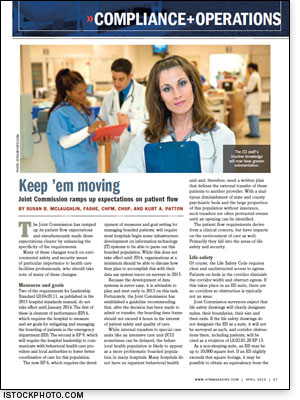
The Joint Commission has ramped up its patient flow expectations and simultaneously made those expectations clearer by enhancing the specificity of the requirements.
Many of these changes touch on environmental safety and security issues of particular importance to health care facilities professionals, who should take note of many of these changes.
Measures and goals
Two of the requirements for Leadership Standard LD.04.03.11, as published in the 2013 hospital standards manual, do not take effect until January 2014. The first of these is element of performance (EP) 6, which requires the hospital to measure and set goals for mitigating and managing the boarding of patients in the emergency department (ED). The second is EP 9, which will require the hospital leadership to communicate with behavioral health care providers and local authorities to foster better coordination of care for this population.
The new EP 6, which requires the development of measures and goal setting for managing boarded patients, will require most hospitals to begin some infrastructure development on information technology (IT) systems to be able to parse out this boarded population. While this does not take effect until 2014, organizations at a minimum should be able to discuss how they plan to accomplish this with their data use system tracer on surveys in 2013.
Because the development of data systems is never easy, it is advisable to plan and start early in 2013 on this task. Fortunately, the Joint Commission has established a guideline recommending that, after the decision has been made to admit or transfer, the boarding time frame should not exceed 4 hours in the interest of patient safety and quality of care.
While internal transfers to special care units like an intensive care unit sometimes can be delayed, the behavioral health population is likely to appear as a more problematic boarded population in many hospitals. Many hospitals do not have an inpatient behavioral health unit and, therefore, need a written plan that defines the external transfer of these patients to another provider. With a multiyear diminishment of state and county psychiatric beds and the large proportion of this population without insurance, such transfers are often protracted events until an opening can be identified.
The patient flow requirements derive from a clinical concern, but have impacts on the environment of care as well. Primarily they fall into the areas of life safety and security.
Life safety impacts
Of course, the Life Safety Code requires clear and unobstructed access to egress. Patients on beds in the corridor diminish the corridor width and obstruct egress. If this takes place in an ED suite, there are no corridors so obstruction is typically not an issue.
Joint Commission surveyors expect that life safety drawings will clearly designate suites, their boundaries, their size and their exits. If the life safety drawings do not designate the ED as a suite, it will not be surveyed as such, and corridor obstructions there, including patients, will be cited as a violation of LS.02.01.20 EP 13.
As a non-sleeping suite, an ED may be up to 10,000 square feet. If an ED slightly exceeds that square footage, it may be possible to obtain an equivalency from the Joint Commission, based on the features of fire protection that are available. If this approach is taken, note that the Centers for Medicare & Medicaid Services (CMS) will not accept that equivalency and a waiver from CMS also must be requested.
It may be possible to divide an oversized suite into two suites with appropriate placement of smoke barriers and exits, another option that might be considered. This approach should be reviewed with an architect to ensure that all Life Safety Code requirements are met.
Another alternative that many hospitals have used is to create observation units near the ED. These units essentially are a transition point between the ED and hospital admissions and serve to alleviate ED overcrowding by using a separate location while decisions are made as to disposition of the patient. Typically this approach is used for medical rather than behavioral health patients.
Security concerns
Security is the second environment of care issue to be considered and it is a significant concern, particularly for behavioral health patients. As explained previously, the holding of an increasing number of behavioral health patients in the ED while waiting for extended time periods for an available bed in the area is a significant contributor to patient flow issues in acute care hospitals.
National Patient Safety Goal 15 Standard NPSG.15.01.01 requires identification of patients at risk for suicide, and is specifically applicable to psychiatric hospitals and patients being treated for emotional or behavioral disorders in general hospitals. The scope for the purposes of this article will be limited to general hospitals.
The Joint Commission's existing NPSG 15 has for several years required hospitals and behavioral health care organizations to screen patients for the risk of suicide. To a large extent organizations do this, although most organizations have not gone into as much depth in developing their screening tools as was suggested by the Joint Commission in its booster pack for this safety goal.
Remember, too, that suicide screening is conducted not because it is a requirement, but because the results lead to appropriate decisions made based on the clinical screening. The clinical screening process should help plan for patient safety as a result of the information learned during the screening.
Once that determination is made, the next consideration is the ED treatment room in which the patient will be placed. Regardless of the features of the room, it is important that it not have direct visual access to the exit from the ED. Doing so is a temptation for an elopement.
Sometimes ED staff members hope to keep the patient safe because his or her room is close to the nursing station, making it more likely that self-injurious behavior will be noted if attempted. This is not a safe and effective strategy.
The suicide screening should help guide placement in a more environmentally safe room; guide what additional medical devices and equipment will be removed from the room; the level of precautions that will be provided, up to and including 1:1 supervision, if needed; and who will provide that 1:1 supervision — a sitter or a trained security guard. Most importantly, the screening also should begin to guide treatment until such time that the patient can be transferred to a more appropriate treatment setting.
NPSG.15.01.01, EP 1, also requires an environmental suicide risk assessment in addition to the clinical assessment. The nature of the assessment is to evaluate the room(s) in which these patients will be placed, as well as the restrooms they will use. These spaces should be evaluated for potential risks, including sharp objects, cords and attachment points.
Some organizations have specially designed rooms from which these items have been removed. Unfortunately, there are times when those rooms will be occupied by other types of patients when the ED is full. If no adjustments to patient placement are possible, the behavioral health patient will end up in a regular treatment room anyway. Thus, to mitigate potential self-injury a facility may have to enhance the level of supervision. Other facilities have "garage door" arrangements where a door can be pulled down over medical equipment that could pose a risk. Another alternative is to remove some or all of the risks when an at-risk patient is placed in the room.
The environmental suicide risk-assessment process should include a listing of the potential risks in these spaces. Each identified risk should be evaluated for potential mitigation. The intention is not that all ED spaces occupied by potentially suicidal patients be devoid of any and all risks. What it means is that the risks should be understood and managed. Of course, there is the choice to mitigate each risk, but there is a range of options available to manage the clinical risk by providing one-on-one observation, which potentially could include the restroom.
There is another more clinical expectation detailed in Provision of Care Standard PC.01.01.01, EP 4, an existing requirement for having a written plan for managing these behavioral health patients. This has been expanded for 2013 with a new EP 24, which details environmental safety from self-injury, orientation and training for the staff serving these patients, and patient assessment and reassessment to identify needs and then to meet those needs. The restraint training that most hospitals already provide for ED clinicians usually will cover the requirements for de-escalation, alternatives to restraint and safe use of restraint when alternatives are ineffective.
Development of the clinical treatment skills until a transfer can be effected probably will be the most challenging. Many county and city authorities already have triage or treatment teams, which are available for referral and screening. As hospitals gather their data and begin to understand the metrics on the scope of this problem, this may be useful leverage to enhance local support for this population, as well as understand its impact on hospital staff and on hospital function.
Meaningful change
While being mandated to monitor and measure is never desired, some useful information may be learned from this requirement. More importantly, meaningful change may be effected in our hospitals by becoming more knowledgeable about the facts and figures on this boarded population.
What has been known about this problem intuitively by ED staff now will have greater substantiation, potentially leading to better management of the process. The dialogue with state and local mental health authorities is a good starting point to improve referral processes and local treatment until a transfer can be made.
Susan B. McLaughlin, FASHE, CHFM, CHSP,is managing director of MSL Healthcare Consulting Inc., Barrington, Ill., and Kurt A. Patton is CEO of Patton Healthcare Consulting, Glendale, Ariz. They can be reached at smclaughlin@mslhealthcare.com and Kurt@Pattonhc.com.
| Sidebar - Improving ED operations |
| Security and patient throughput rarely are considered complementary concepts, but these two easily came together in 2010 at the Medical Center of Columbus (Ga.) Regional Healthcare System Inc. Prior to these changes, psychiatric evaluation patients were being held in the emergency department (ED) for many hours after a physician had medically cleared them and signed the paperwork. Often the long wait time resulted in the loss of the inpatient bed at the accepting facility. Moreover, the hospital's security staff were relying on the local sheriff's office for transport, but their manpower was stretched thinly. The hospital's security officers are Georgia Peace Officer Standards & Training Council-certified as well as reserve deputy sheriffs with full arrest powers. This arrangement gives these officers the same authority to transport psychiatric evaluation patients as the full-time deputies. Consequently, the sheriff of Muscogee County was approached with a plan to assign a sheriff's vehicle to be stationed at the Medical Center, and the hospital's deputies would transport psychiatric evaluation patients who were being admitted to two of the local inpatient facilities. A memorandum of understanding was drawn up and the hospital began transporting these patients from the Medical Center and its sister hospital, Doctors Hospital, in September 2010. A performance measure target for the transports was less than 30 minutes. For clarity, this time was measured from when the patient paperwork was signed by the attending physician until the officer began the transport. The first month, the transports were at 25 minutes and continued to trend downward each month thereafter, reaching 21 minutes in December 2010. The security department has continued to monitor the time and has consistently been at less than 30 minutes each month. This successful project has steadily reduced the ED boarding time of psychiatric evaluation patients. Long wait times agitate these patients. By consistently transporting them out in less than 30 minutes, hospital security staff have improved staff safety and freed up staff to attend to other patients as well as reduced the boarding cost in the ED. This program recently was recognized during the Medical Center's triennial survey by the Joint Commission to be submitted as a best practice. By Tom Barnes, director of corporate security at Columbus Regional Healthcare System Inc. He can be reached at tom.barnes@crhs.net. |





